Doppler Effect In Sound
Effect Of Relative Motion Between A Source Of Souno And A Listener When a train approaches a station sounding its horn, the pitch of the sound seems to be higher to a listener standing on the platform.
Again, when the train passes the platform and moves away from the station, the same sound seems to be of a lower pitch to the listener.
- On the other hand, if the source of sound is at rest and the listener approaches it or moves away from it, the pitch of the sound appears to be higher or lower, respectively. These phenomena are known as the Doppler effect.
- We know that the pitch of sound is determined by its frequency. So, an apparent change in the frequency of sound is caused by the relative motion of the source of sound and the listener and this is known as the Doppler effect.
Doppler effect: The apparent change in the pitch of a note due to the relative motion of the source of sound and the listener is called the Doppler effect.
Doppler shift: Let n be the actual frequency of a source of sound and n’ be the apparent frequency of it due to the relative motion of the source and the listener. The apparent change in frequency, i.e., (n’ -n) is called the Doppler shift. The apparent increase or decrease of the pitch of sound refers to positive or negative Doppler shifts, respectively.
Experimental demonstration: A source of sound S which can emit continuous sound of the same frequency (for example, a whistle or a bell driven by a battery) is taken. It is tied to one end of a strong thread of length about 2 m to 3 m and whirled at a high speed along a circle ABCDA with P as the centre.
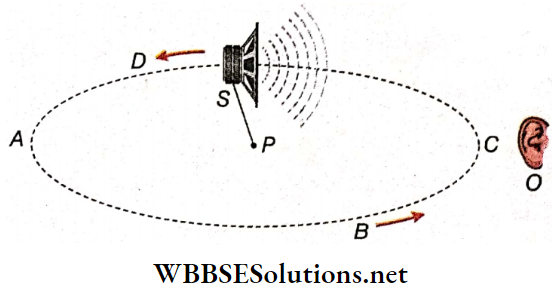
- Under this condition, a listener at O can easily recognise the successive increase and decrease of the pitch of the sound.
- This increase or decrease of the pitch is due to the Doppler effect. When the source S along the arc ABC approaches the listener the pitch of the sound is increased. When along CDA the source recedes from the listener, the pitch of the sound is decreased.
Doppler Effect In Sound Calculation Of Apparent Frequency And Doppler Shift
Let the velocity of sound in the air be V and the actual frequency of the source of sound be n.
So, the wavelength of the sound wave emitted from the source in air, \(\lambda=\frac{V}{n}\)…(1)
Effect of the motion of the listener: Suppose, the listener O is approaching a stationary source of sound S with velocity u0. Since the source is at rest, n number of waves extend over the distance V in the direction of the listener, i.e., n number of waves extend over the distance traversed by the sound wave in unit time.

- So, the length of the sound wave that reaches the ears of the listener at O is given by \(\frac{V}{n}\). Thus, the wavelength of the sound remains unchanged. So it may be said that, n ∝ V.
- In this case, the velocity of sound relative to the listener is not V, rather the apparent velocity of sound relative to u0 (the velocity of the listener) increases and becomes V’ = V+ u0. So, the frequency of the sound heard by the listener also increases.
Effect of the motion of the source: Suppose, the source S is approaching the listener O at rest with velocity us.
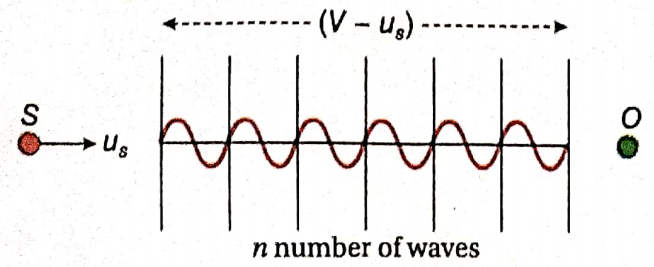
- Since the listener is at rest, the velocity of sound relative to him is, V i.e., in this case, the velocity of sound remains unchanged. So, it may be said that, \(n \propto \frac{1}{\lambda}\).
- Now in this case, n number of waves do not extend over the distance V in the direction of the listener; rather due to the velocity of the source (us), the distance covered by n number of waves = V- us.
- Thus the apparent wavelength of the sound wave decreases and becomes \(\lambda^{\prime}=\frac{V-U_s}{n}\). Hence, the frequency of the sound heard by the listener increases.
Effect of the motion of both the listener and the Source: If the listener and the source both are in motion, the apparent frequency of the sound heard by the listener is given by,
⇒ \(n^{\prime}=\frac{V^{\prime}}{\lambda^{\prime}}=\frac{V+u_o}{\frac{V-u_s}{n}} \text { or, } n^{\prime}=\frac{V+u_o}{V-u_s} \times n\) ….(2)
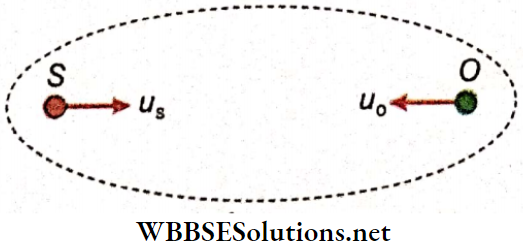
∴ Doppler shift = \(n^{\prime}-n=\frac{u_s+u_o}{V-u_s} \times n\)…(3)
Frequency And Doppler Shift Special cases:
Source at rest and listener In motion: In this case, us = 0. So, from equations (2) and (3),
n’ = \(\frac{V+u_o}{V} \times n \quad \text { and } n^{\prime}-n=\frac{u_o}{V} \times n\)
Listener at rest and source in motion: In this case, u0 = 0. So, from the equations (2) and (3),
n’ = \(\frac{V}{V-u_s} \times n \quad \text { and } n^{\prime}-n=\frac{u_s}{V-u_s} \times n\)
Frequency And Doppler Shift Discussions:
1. It is very important to use positive and negative signs properly while putting the values of u0 and us in the equations (2) and (3). The rule, that is followed, is:
- If the listener moves towards the source, u0 is positive.
- If the source moves towards the listener, us is positive.
- Conversely:
- If the listener moves away from the source, u0 is negative.
- If the source moves away from the listener, us is negative.
- Conversely:
In general, it may be said that if u0 and us are inclined at an angle θ with the direction of motion of sound, u0cosθ and uscosθ are to be placed in equations (2) and (3).
2. It is evident that if there Is no relative motion between the source and the listener, then us = -u0. In that case, no Doppler effect takes place [equations (2) and (3)]. If the distance between the source and the listener decreases with respect to time, the apparent pitch of the sound increases and vice versa.
3. While calculating apparent frequency and Doppler shift it has been assumed that the velocities of both the source and the listener are less than that of sound in air, i.e., us < V and u0 < V. If the velocity of either the source or the listener exceeds the velocity of sound (i.e., it becomes supersonic), the nature of Doppler effect becomes entirely different.
4. Effect of wind: Let the velocity of wind be v. If the wind blows in the direction of motion of sound, v is positive. Then the apparent velocity of sound relative to the listener at rest = V+ v. So, in the calculation of the Doppler effect, the velocity of sound V is to be replaced by V+ v. In that case, equations (2) and (3) become,
n’ = \(\frac{V+v+u_o}{V+v-u_s} \times n\)…(4)
and \(n^{\prime}-n=\frac{u_s+u_o}{V+v-u_s} \times n\)…(5)
It is obvious that if the wind blows in the opposite direction, -v is to be placed instead of v in equations (4) and (5).
5. Doppler effect in case of echo: Let the source of sound S be moving towards the stationary reflector R with velocity us. The velocity of the listener O is u0 in the same direction.
In this case for the echo produced by the reflector R, S’ is the apparent source of sound which is the image of the principal source S. The listener O is approaching the apparent source S’ and the apparent source S’ is also approaching the listener O. So, u0 and us are both positive.
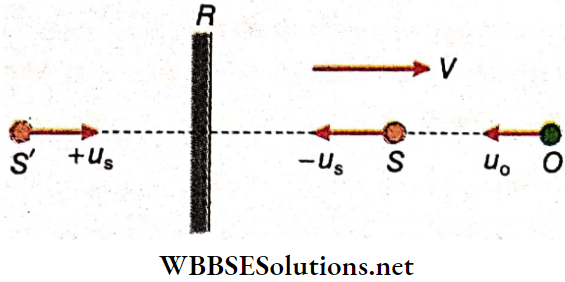
∴ Apparent frequency n’ = \(\frac{V+u_o}{V-u_s} \times n\)…(6)
Here, both the source S and the observer O are moving towards the reflector. If any of them moves in the opposite direction, i.e., recedes from the reflector, us or u0 in equation (6) is replaced by -us or -u0.
Again, as a special case, if the positions of the source of sound and the listener always remain the same (for example, the horn of a car and a passenger of the same car), then us = u0.
Then according to equation (6), \(n^{\prime}=\frac{V+u_o}{V-u_o} \times n\)
Formation of beats due to original sound and its echo: If the difference between the actual frequency and the apparent, frequency due to the Doppler effect (i.e., n-n’ or n’-n) is less than 10 Hz, then the original sound and its echo are superposed and beats are formed.
Doppler Effect In Sound Frequency And Doppler Shift Numerical Examples
Example 1. The frequency of the whistle of a train Is 512 Hz. The train crosses a station at a speed of 72km · h-1. Calculate the frequency of the sound heard by a listener, standing on the platform, before and after the train crosses the station. Neglect the effect of wind. The velocity of sound is 336 m · s-1.
Solution:
Velocity of the train = 72 km · h-1
= \(\frac{72 \times 1000}{60 \times 60} \mathrm{~m} \cdot \mathrm{s}^{-1}\)
= 20 m · s-1
When the train approaches the station, the distance covered by 512 sound waves =336-20 =316 m
∴ Apparent wavelength, \(\lambda^{\prime}=\frac{316}{512} \mathrm{~m}\)
∴ Apparent frequency due to the Doppler effect
= \(\frac{\text { velocity of sound }(V)}{\lambda^{\prime}}\)
= \(\frac{336}{\frac{316}{512}}=\frac{336 \times 512}{316}=544.4 \mathrm{~Hz}\)
Again, when the train recedes from the station, the distance covered by 512 sound waves = 336 + 20 = 356 m
∴ Apparent wavelength, \(\lambda^{\prime}=\frac{356}{512} \mathrm{~m}\)
∴ Apparent frequency = \(\frac{V}{\lambda^{\prime}}=\frac{336}{\frac{356}{512}}=\frac{336 \times 512}{356}=483.2 \mathrm{~Hz}\)
Alternative Method:
According to the question, the listener is at rest and the source is in motion. So, the apparent frequency to the listener,
n’ = \(\frac{V}{V-u_s} \times n\)
In the first case, V = \(336 \mathrm{~m} \cdot \mathrm{s}^{-1}, n=512 \mathrm{~Hz}\)
and \(u_s=72 \mathrm{~km} \cdot \mathrm{h}^{-1}=\frac{72 \times 1000}{60 \times 60}=20 \mathrm{~m} \cdot \mathrm{s}^{-1}\)
∴ \(n^{\prime}=\frac{336}{336-20} \times 512=\frac{336}{316} \times 512=544.4 \mathrm{~Hz}\)
In the second case, V = \(336 \mathrm{~m} \cdot \mathrm{s}^{-1}, n=512 \mathrm{~Hz}\)
and \(u_s=-20 \mathrm{~m} \cdot \mathrm{s}^{-1}\)
∴ \(n^{\prime}=\frac{336}{336-(-20)} \times 512=\frac{336 \times 512}{356}=483.2 \mathrm{~Hz}\)
Example 2. A sound of frequency 512 Hz Is emitted from a stationary source. A train running at a speed of 72 km · h-1 passes the source. What will be the frequency of the sound heard by a passenger of the train before and after passing the source? Neglect the effect of wind. The velocity of sound is 336 m · s-1.
Solution:
Velocity of the train = 72 km · h-1
= \(\frac{72 \times 1000}{60 \times 60} \mathrm{~m} \cdot \mathrm{s}^{-1}=20 \mathrm{~m} \cdot \mathrm{s}^{-1}\)
When the train approaches the source, the velocity of sound relative to the passenger,
V’ = 336 + 20 = 356 m · s-1
Since the source is at rest, the wavelength of sound remains the same.
∴ Apparent frequency due to the Doppler effect
= \(\frac{V^{\prime}}{\lambda}=\frac{V^{\prime}}{\frac{V}{n}}=\frac{V^{\prime} n}{V}=\frac{356 \times 512}{336}=542.5 \mathrm{~Hz}\)
Again when the train recedes from the source, the velocity of sound relative to the passenger V’ = 336 – 20 = 316 m · s-1
∴ Apparent frequency = \(\frac{V^{\prime} n}{V}=\frac{316 \times 512}{336}=481.5 \mathrm{~Hz}\)
Example 3. When a train approaches a listener, the apparent frequency of the whistle is 100Hz, while the frequency appears to be 50 Hz when the train recedes. Calculate the frequency when the listener is in the train.
Solution:
If the listener is in the train, he will listen to the actual frequency of the whistle (n).
If V is the velocity of sound, us is the velocity of the source and u0 is the velocity of the listener,
the apparent frequency, \(n^{\prime}=\frac{V+u_o}{V-u_s} \times n\)
In the given problem, in both cases, the listener is at rest. So, u0 = 0
In the first case, the motion of the train is towards the listener. So, us is positive.
Again in the second case, the train recedes from the listener. So, us is negative.
Therefore, in the two cases we have, \(100=\frac{V+0}{V-u_s} \times n\)
or, \(\frac{V}{V-u_s} \times n=100\)….(1)
and \(50=\frac{V+0}{V-\left(-u_s\right)} \times n\)
or, \(\frac{V}{V+u_s} \times n=50\)….(2)
From equation (1), \(\frac{n}{100}=\frac{V-u_s}{V}=1-\frac{u_s}{V} \quad \text { or, } \frac{u_s}{V}=1-\frac{n}{100}=\frac{100-n}{100}\)
From equation (2), \(\frac{n}{50}=\frac{V+u_s}{V}=1+\frac{u_s}{V} \quad \text { or, } \frac{u_s}{V}=\frac{n}{50}-1=\frac{n-50}{50}\)
∴ \(\frac{100-n}{100}=\frac{n-50}{50} \quad \text { or, } 100-n=2 n-100\)
or, \(3 n=200 \quad \text { or, } n=66 \frac{2}{3} \mathrm{~Hz}\)
Example 4. Two engines pass each other in opposite directions. One of them blows a whistle of frequency 540 Hz. Find the frequencies heard by a passenger sitting on the other engine before and after passing each other. The velocity of both engines = 72 km · h-1; velocity of sound =340 m · s-1.
Solution:
Velocity of the engine,
u = \(72 \mathrm{~km} \cdot \mathrm{h}^{-1}=\frac{72 \times 1000}{60 \times 60} \mathrm{~m} \cdot \mathrm{s}^{-1}=20 \mathrm{~m} \cdot \mathrm{s}^{-1}\)
Velocity of sound, V = 340 m · s-1;
Actual frequency, n = 540 Hz
At the time of approaching each other, the velocity of the whistle, us = +20 m · s-1
The velocity of the passenger on the other engine, u0 = +20 m · s-1
∴ Apparent frequency,
n’ = \(\frac{V+u_o}{V-u_s} \times n\)
= \(\frac{340+20}{340-20} \times 540=\frac{360}{320} \times 540=607.5 \mathrm{~Hz}\)
Again at the time of receding from each other, us = -20 m · s-1 and u0 = -20 m · s-1
∴ Apparent frequency,
n’ = \(\frac{V+u_o}{V-u_s} \times n\)
= \(\frac{340-20}{340-(-20)} \times 540=\frac{320}{360} \times 540=480 \mathrm{~Hz}\)
Example 5. A car travelling at a speed of 36 km · h-1 sounds its horn of frequency 500 Hz. It is heard by the driver of another car which Is travelling behind the first car In the same direction with a velocity of 20 m · s-1. Another sound Is heard by the driver of the second car after reflection from a bridge ahead. What will be the frequencies of the two sounds heard by the driver of the second car? Sound travels in air with a speed of 340m · s-1.
Solution:
The driver of the second car O is the listener. The first car S and its image S’ due to reflection on the bridge ahead are two sources of sound.
The direction of motion of O is towards S and S’.
So velocity of the listener, u0 = + 20 m · s-1
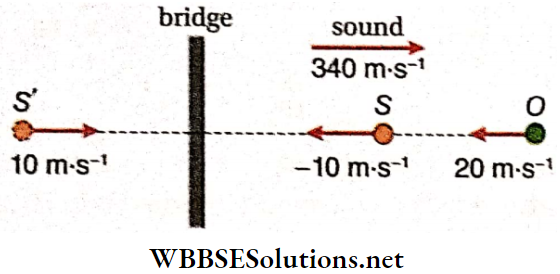
Here, S is receding from O. So, the velocity of the source S,
u0 = -36 km · h-1
= \(-\frac{36 \times 1000}{60 \times 60} \mathrm{~m} \cdot \mathrm{s}^{-1}\)=\(-10 \mathrm{~m} \cdot \mathrm{s}^{-1}\)
∴ Apparent frequency to the listener due to S,
n’ = \(\frac{V+u_o}{V-u_s} \times n\)
= \(\frac{340+20}{340-(-10)} \times 500\)
= \(\frac{360}{350} \times 500=514.3 \mathrm{~Hz}\)
On the other hand, S’ is approaching O.
So, velocity of the source S’, us = +10 m · s-1
∴ Apparent frequency to the listener due to S’,
n’ = \(\frac{V+u_o}{V-u_s} \times n=\frac{340+20}{340-10} \times 500\)
= \(\frac{360}{330} \times 500=545.5 \mathrm{~Hz}\)
So the driver of the second car will hear the sounds of frequencies 514.3 Hz and 545.5 Hz.
Example 6. A whistle, emitting a sound of frequency 440 Hz, is tied to a thread of length 1.5 m and rotated with an angular velocity of 20 rad · s-1 on a horizontal plane, Calculate the range of frequency of the sound heard Velocity of sound in air =330 m · s-1
Solution:
Linear velocity of the whistle (u)
= angular velocity x radius of the circular path
= 20 x 1.5 = 30 m · s-1
The velocity of the whistle at that position of the circular path where the whistle approaches the listener.
us = +30m · s-1
∴ Apparent frequency, \(n_1 =\frac{V}{V-u_s} \times n=\frac{330}{330-30} \times 440\)
= \(\frac{330}{300} \times 440=484 \mathrm{~Hz}\)
Again, the velocity of the whistle at that position of the circular path where the whistle recedes from the listener, u’s =-30m-s_1
Apparent frequency, \(n_2 =\frac{V}{V-u_s^{\prime}} \times n=\frac{330}{330-(-30)} \times 440\)
= \(\frac{330}{360} \times 440=403.3 \mathrm{~Hz}\)
So, the range of frequency is 403.3 Hz to 484 Hz.
Example 7. Each of the two persons has a whistle of frequency 500 Hz. One person is at rest at a particular place and the second person recedes from him with a velocity of 1.8 m · s-1. If both of them blow whistles, how many beats will be heard by each of them? The velocity of sound = 330 m · s-1.
Solution:
Both of them listen to the sound of frequency 500 Hz for their own whistles.
In the first case, let us suppose that the first person is listening to the sound coming from the whistle of the second person.
Here the velocity of the listener, u0 = 0
Since the source is receding, the velocity of the source, us = -1.8 m · s-1
∴ Apparent frequency,
n’ = \(\frac{V}{V-u_s} \times n=\frac{330}{330-(-1.8)} \times 500=497.29 \mathrm{~Hz}\)
∴ Number of beats per second = n-n’ = 500-497.29
= 2.71 ≈ 3
In the second case, let us suppose that the second person is listening to the sound coming from the whistle of the first person.
Here the velocity of the source, us = 0
Since the listener is receding,
The velocity of the listener, u0 = -1.8 m · s-1
∴ Apparent frequency,
n’ = \(\frac{V+u_o}{V} \times n=\frac{330-1.8}{330} \times 500=497.27 \mathrm{~Hz}\)
∴ Number of beats per second = n-n’ =500-497.27
= 2.73 ≈ 3
Example 8. A siren placed at a railway platform is emitting sound of frequency 5 kHz. A passenger sitting in a moving train A records a frequency of 5.5 kHz while the train approaches the siren. During his return journey in a different train B he records a frequency of 6.0 kHz while approaching the same siren. What is the ratio of the velocity of train B to that of train A?
Solution:
Let, uA be the velocity of train A.
∴ Frequency of siren relative to the passenger of train A \(n_1=n\left(\frac{V+u_A}{V}\right)\)
∴ \(5\left(\frac{V+u_A}{V}\right)=5.5\)….(1)
Similarly, the frequency of the siren relative to the passenger of train B,
⇒ \(n_2=n\left(\frac{V+u_B}{V}\right) \quad\left[u_B=\text { velocity of train } B\right]\)
∴ \(5\left(\frac{V+u_B}{V}\right)=6\)…(2)
From equation (1), 5.5 V- 5 V = 5 uA
∴ V = \(\frac{5}{0.5} u_A\)….(3)
From equation (2), 6V-5V = 5uB
∴ V = 5uB……(4)
Comparing equations (3) and (4), \(\frac{5}{0.5} u_A=5 u_B\)
∴ \(\frac{u_B}{u_A}=\frac{1}{0.5}=\frac{2}{1}\)
∴ \(u_B: u_A=2: 1\)
Example 9. A railway track and a road are mutually perpendicular. A train Is approaching the railway crossing at a speed of 80 km/h. When the train h at a distance 1 km from the crossing it blows a whistle of frequency 400 Hz. Which frequency of sound will he hear from a man on a road at a distance of 600 m from the crossing? velocity of sound =330 m · s-1
Solution:
Train (S) is moving with a velocity 80 km/h along SA. At the time of blowing the whistle, the distances of the train and a man (O) from the crossing (A) are 1 km and 600 m respectively.
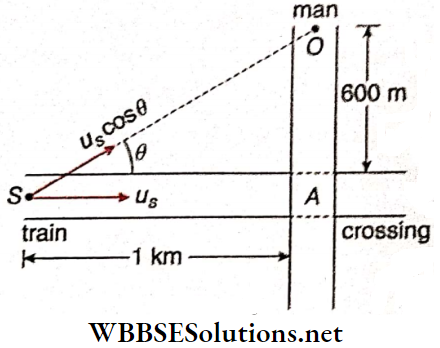
∴ SA = 1 km = 1000 m; OA = 600 m
If uS be the velocity of the train, the component along SO is uS cosθ.
∴ \(\cos \theta=\frac{S A}{S O}=\frac{S A}{\sqrt{S A^2+A O^2}}=\frac{100}{\sqrt{(1000)^2+(600)^2}}=0.8575\)
∴ \(u_S \cos \theta=80 \times \frac{5}{18} \times 0.8575=19.05 \mathrm{~m} \cdot \mathrm{s}^{-1}\)
∴ Apparent frequency of sound, n’ = \(\frac{V}{V-u_S \cos \theta} n\)
Here, V = velocity of sound = 330 m · s-1 and actual frequency, n = 400 Hz
∴ n’ = \(\frac{330}{330-19.05} \times 400=424.5 \mathrm{~Hz}\)
Doppler Effect In Sound and Light
Like sound, the Doppler effect also takes place in the case of light waves. When a source of light and an observer are in relative motion, an apparent change in the frequency, i.e., the wavelength of light is perceived in the eyes of the observer.
It means that the colour of the light is found to change in the eyes of the observer. This Doppler effect of light is of two kinds.
Redshift: When the source and the observer recede from each other, the wavelength of the light apparently increases. This apparent increase of wavelength due to the Doppler effect is called redshift. This is a displacement of the Lines in the spectra towards the red end of the visible spectrum (i.e., towards a longer wavelength).
Blueshift: When the source and the observer approach each other, the wavelength of the light apparently decreases. This apparent decrease of wavelength is called blue shift. This is a displacement of the lines in the spectra towards the blue end of the visible spectrum (i.e., towards a shorter wavelength).
Calculation of apparent wavelength and Doppler shift: Let the velocity of light in a vacuum be c, the original frequency of a monochromatic light be n and the original wavelength of the light, \(\lambda=\frac{c}{n}\).
Now suppose that the source of this monochromatic light and an observer approach each other with relative velocity u. In that case, n number of waves produced per second do not occupy the distance c, rather the distance occupied by those n number of waves = c- u
So, the apparent wavelength is \(\lambda^{\prime}=\frac{c-u}{n}=\frac{c}{n}\left(1-\frac{u}{c}\right) \quad \text { or, } \lambda^{\prime}=\left(1-\frac{u}{c}\right) \lambda\)…(1)
∴ Doppler shift of wavelength = \(\lambda^{\prime}-\lambda=-\frac{u}{c} \lambda\)….(2)
Doppler Effect Of Light Special cases:
- When the source approaches the observer, u is positive in equations (1) and (2). So, λ’ is less than λ, i.e., the wavelength apparently decreases. It is the phenomenon of blue shift.
- When the source recedes from the observer, u is negative in equations (1) and (2). So, λ’ is greater thanλ, i.e., the wavelength apparently increases. It is the phenomenon of redshift.
Doppler Effect Of Light Discussions:
1. Velocity of light in vacuum, c = 3 x 108 m · s-1. If the relative velocity of the source and the observer is very small, i.e., u<<c or, \(\frac{u}{c} \ll 1\), then according to equation (1), λ’ ≈ λ. In this case, the Doppler effect is practically absent. So when a train or motor car lighting their headlights approaches an observer, red or blue shift becomes negligible, i.e., no apparent change in the colour of light takes place.
2. On the other hand, if the relative velocity of the source and the observer is nearly equal to the velocity of light, i.e., u<<c or, \(\frac{u}{c} \approx 1\) then according to equation (1), λ’ ≈ 0. But in practical cases the wavelength never becomes zero or nearly zero. So it is evident that if u ≈ c, equation (1) is no longer applicable.
In that case, the corrected form of equation (1) will be \(\lambda^{\prime}=\lambda \sqrt{\frac{c-u}{c+u}}\) and the associated frequency will be, \(n^{\prime}=n \sqrt{\frac{c+u}{c-u}}\).
The theory of relativity is essential to reach these equations which is out of the current syllabus.
3. The Doppler effect of light differs remarkably from that of sound. The relative velocity of sound increases or decreases when the listener is in motion with respect to the source of sound.
- On the other hand, the velocity of light, as proposed in the theory of relativity, is always equal to c, whatever be the relative velocity of the observer and the source.
- Hence Doppler effect of light takes place for the relative velocity u of the source and the observer. Here, it is not necessary to consider the velocities of the source of light and the observer separately.
Application of Doppler effect of light:
1. Velocity of Slots: The velocity of a distant star relative to the earth can be determined by measuring the Doppler shift of the light that comes to the Earth from the star. Generally, for a star or galaxy of stars, this shift is a red shift from which it is understood that these stars are receding gradually from the earth (velocity of separation is 10 km · s-1 to 300km · s-1). This observation supports the theory of an expanding universe.
2. Binary Star: For a star, if both red shift and blue shift are observed, it may be concluded that the star is actually a binary star. The two stars are revolving around a common axis.
3. Quasar: The redshift of these stars is very high. Calculations show that these stars are receding from the earth at a tremendously high speed (in some cases tire speed becomes 80% of the speed of light).
4. Rotation of the sun about its own axis: As the sun rotates about its axis, one side faces the earth while the other side goes behind it. So, a blue shift for one side and a rod shift for the other side are observed. From the calculations of these shifts, it is found that the speed of rotation of the sun is about 2 km · s-1.
5. Doppler radar: It is used to measure the speed of an aeroplane flying at a high speed. The waves emitted from a Doppler radar are reflected from a flying aeroplane. By measuring the Doppler shift of the reflected radar waves, the speed of the aeroplane can be determined.
6. Measurement of high temperature: A blue shift is observed in the light emitted by a hot substance when the molecules of the substance move towards the observer. Whereas a red shift is observed when the molecules move away from the observer.
Measuring this shift, the expression of rms velocity of die molecules is determined. Next from the expression of rms velocity = \(\sqrt{\frac{3 R T}{M}}\), the temperature T is obtained (M = Mass of 1 mol of the substance).
Doppler Effect In Sound Doppler and Light Conclusion
The apparent change in the pitch of a note due to relative motion between a source of sound and a listener is called the Doppler effect.
If n is the actual frequency of a source of sound and n’ is the apparent frequency of it due to the relative motion of the source and the listener, the apparent change in frequency (n’ -n) is called Doppler shift.
- No Doppler effect can be noticed by an observer in the absence of any relative motion between the source and observer.
- When the source and the observer recede from each other, an apparent increase in the wavelength of light Is observed. This apparent increase of wavelength due to the Doppler effect is called redshift. This is a displacement of the lines in a spectrum towards the red end (i.e., towards a longer wavelength).
- When the source and the observer approach each other, an apparent decrease in the wavelength of light is observed. This apparent decrease of wavelength is called blue shift. This is a displacement of the lines in a spectrum towards the blue end (i.e., towards a shorter wavelength).
Doppler Effect In Sound Doppler Effect Of Light Useful Relations For Solving Numerical Examples
If the listener and the source are both in motion, the apparent frequency of the sound heard by the listener is,
n’ = \(\frac{V+u_o}{V-u_s} n\)
where V = velocity of sound in air, n = actual frequency of source of sound, us = velocity of the source of sound.
Doppler shift, n’ -n = \(\frac{u_s+u_o}{V-u_s} n\)
Sign convention:
- If the listener moves towards the source, u0 is positive,
- If the source moves towards the listener, us is positive.
- Conversely,
- If the listener moves away from the source, u0 is negative,
- If the source moves away from the listener, us is negative.
- Conversely,
If the velocity of wind is v and if the wind blows in the direction of motion of sound, then n’ = \(\frac{V+v+u_o}{V+v-u_s} n\)
If the velocity of wind is v and if the wind blows in the opposite direction of motion of sound, then n’ = \(\frac{V-v+u_o}{V-v-u_s} n\)
A car moving towards a stationary reflector with velocity u0 blows a horn of frequency n. The frequency of echo heard by the passenger of the car will be
n’ = \(\frac{V+u_0}{V-u_0} n\)
A stationary car blows a horn of frequency n. If a reflecting surface moves towards the car with velocity us, the frequency of echo heard by the passenger of the car is
n’ = \(\frac{V+u_s}{V-u_s} n\)
Some Important Cases of the Doppler Effect
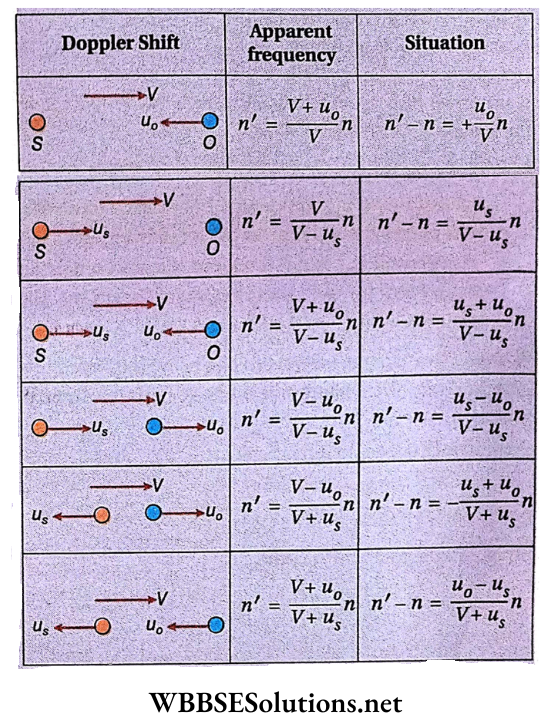
Doppler Effect In Sound Doppler Effect Of Light Very Short Answer Type Questions
Question 1. Which property of sound undergoes an apparent change due to the Doppler effect?
Answer: Pitch
Question 2. When a source moves at a speed greater than that of sound, will the Doppler effect hold?
Answer: No
Question 3. Will there be a Doppler effect for sound when the source and listener move at a right angle to the line joining them?
Answer: No
Question 4. When a source of sound approaches a stationary listener, the sound appears to be _______ to the listener.
Answer: Sharper
Question 5. When a listener approaches a source of sound, the sound appears to be ______ to the listener.
Answer: Sharper
Question 6. The apparent change of frequency of sound due to the Doppler effect is called Doppler ______
Answer: Shift
Question 7. If there is a relative motion between a source of light and an observer, a change of colour of the light appears in the eyes of the observer. What is the name of this phenomenon?
Answer: Doppler effect of light
Question 8. When a source of light and an observer recede from each other, the apparent change in the wavelength of light is called _______ shift.
Answer: Red
Doppler Effect In Sound Doppler Effect Of Light Assertion Reason Type Questions And Answers
Direction: These questions have statement 1 and statement 2. Of the four choices given below, choose the one that best describes the two statements.
- Statement 1 is true, statement 2 is true; statement 2 is a correct explanation for statement 1.
- Statement 1 is true, and statement 2 is true; statement 2 is not a correct explanation for statement 1.
- Statement 1 is true, statement 2 is false.
- Statement 1 is false, and statement 2 is true.
Question 1.
Statement 1: The intensity of sound waves changes when the listener moves towards or away from the stationary source.
Statement 2: The motion of the listener causes the apparent change in wavelength.
Answer: 3. Statement 1 is true, statement 2 is false.
Question 2.
Statement 1: When there is no relative velocity between the source and observer, then the observed frequency is the same as emitted.
Statement 2: The velocity of sound when there is no relative velocity between the source and observer is zero.
Answer: 3. Statement 1 is true, statement 2 is false.
Doppler Effect In Sound Doppler Effect Of Light Match Column 1 With Column 2
Question 1. Source has frequency f. Source and observer both have the same speed. The apparent frequency observed by the observer matches the following:
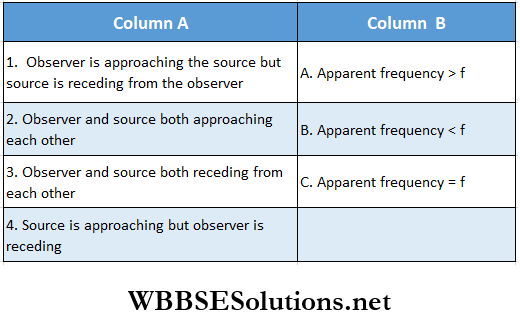
Answer: 1. C, 2. A, 3. B, 4. C
Doppler Effect In Sound Doppler Effect Of Light Comprehension Type Questions And Answers
Read the following passages carefully and answer the questions at the end of them.
Question 1. A source 5 of an acoustic wave of frequency v0 = 1700 Hz and a receiver R are located at the same point. At the instant t = 0, the source starts from rest to move away from the receiver with a constant acceleration ω. The velocity of sound in air is v = 340 m · s-1.
1. If ω = 10 m · s-2, the apparent frequency that will be recorded by the stationary receiver at t = 10 s will be
- 1700 Hz
- 1.35 Hz
- 850 Hz
- 1.27 Hz
Answer: 2. 1.35 Hz
2. if ω = 0 for t> 10 s, the apparent frequency recorded by the receiver at t = 15 s will be
- 1700Hz
- 1310Hz
- 850Hz
- 1.23kHz
Answer: 2. 1310Hz
3. If ω = 10 m · s-2, the apparent frequency that will be recorded by the stationary receiver just at the instant when the source is exactly 1 km away from the receiver will be
- 1700 Hz
- 1310 Hz
- 850 Hz
- 1.26 kHz
Answer: 4. 1.26 kHz
Question 2. A small source of sound vibrating at a frequency 500 Hz is rotated in a circle of radius (100/π)cm at a constant angular speed of 5.0 revolutions per second, The speed of sound in air is 330 m · s-1, An observer (A) is situated at a great distance on a straight line perpendicular to the plane of the circle, through its centre. Another observer (B) is at rest at a great distance from the centre of the circle but nearly in the same plane. After some time the source of sound comes to rest after reaching the centre of the circle, At that time, another observer (C) moves towards the source with a constant speed of 20 m · s-1, along the radial line to the centre.
1. The apparent frequency of the source heard by A will be
- Greater than 500 Hz
- Smaller than 500 Hz
- Always 500 Hz
- Greater for half the circle and smaller during the other half
Answer: 3. Always 500 Hz
2. The minimum and the maximum values of the apparent frequency heard by B will be
- 455 Hz and 535 Hz
- 485 Hz and 515 Hz
- 485 Hz and 500 Hz
- 500 Hz and 515 Hz
Answer: 2. 485 Hz and 515 Hz
3. The change in the frequency of the source heard by C will be
- 6%
- 3%
- 2%
- 9%
Answer: 1. 6%
Doppler Effect In Sound Doppler Effect Of Light Integer Answer Type Questions
In this type, the answer to each of the questions Is a single-digit integer ranging from 0 to 9.
Question 1. The frequency of the sound of a car horn as perceived by an observer towards whom the car is moving differs from the frequency of the horn by 2.5%. Assuming that the velocity of sound in air is 320 m · s-1, find the velocity (in m · s-1) of the car.
Answer: 8
Question 2. A man is watching two trains, one leaving and the other coming in with equal speeds of 4m · s-1. If they sound their whistles, each of frequency 240 Hz, find the number of beats heard by the man (velocity of sound in air =320 m · s-1).
Answer: 6
Question 3. The difference between the apparent frequency of a source of sound as perceived by an observer during its approach and recession is 2% of the natural frequency of the source. If the velocity of sound in air is 300 m · s-1, find the velocity (in m · s-1) of the source.
Answer: 3
Question 4. A stationary source is emitting sound at a fixed frequency f0, which is reflected by two cars approaching the source. The difference between the frequencies of sound reflected from the cars is 1.2% of f0. What is the difference in the speeds of the cars (in km per hour) to the nearest integer? The cars are moving at constant speeds much smaller than the speed of sound which is 330 m· s-1.
Answer: 7
Doppler Effect In Sound Doppler Effect Of Light Short Answer Type Questions
Question 1. Show that, the change in frequency of sound during the motion of the source towards the audience is more than that when the audience moves towards the source with the same velocity.
Answer:
Natural frequency of the source = n;
velocity of sound = V;
velocity of the source = v and
velocity of the audience = u.
So, apparent change in frequency = Doppler shift (Δn)
= \(\frac{\nu+u}{V-\nu} n\)
When the source of sound remains stationary, v = 0.
When the audience moves towards the source, \(\Delta n_1=\frac{u}{V} n\)
When the audience is stationary, u = 0.
when the source moves towards the audience with the same velocity (i.e., v= u), \(\Delta n_2=\frac{u}{V-u} n\)
Clearly, Δn2 > Δn1
Question 2. A car is moving with a speed of 72 km · h-1 towards a roadside source that emits sound at a frequency of 850 Hz. The car driver listens to the sound while approaching the source and again while moving away from the source after crossing it. If the velocity of sound is 340 m · s-1, the difference of the two frequencies, the driver hears is
- 50 Hz
- 85 Hz
- 100 Hz
- 150 Hz
Answer:
Velocity of the car, u0 = 72 km · h-1 = 20 m · s-1
When the car is approaching the source, the apparent frequency is,
∴ \(n_1=\left(\frac{V+u_o}{V}\right) n=\left(\frac{340+20}{340}\right) 850=900 \mathrm{~Hz}\)
When the car moves away from the source, then appar¬ent frequency is,
∴ \(n_2=\left(\frac{V-u_o}{V}\right) n=\left(\frac{340-20}{340}\right) 850=800 \mathrm{~Hz}\)
∴ n1 -n2 = 900 – 800 = 100 Hz
The option 3 is correct.
Question 3. A train is moving with a uniform speed of 33 m/s and an observer is approaching the train with the same speed. If the train blows a whistle of frequency 1000 Hz and the velocity of sound is 333 m/s, then the apparent frequency of the sound that the observer hears is
- 1220 Hz
- 1099 Hz
- 1110 Hz
- 1200 Hz
Answer:
Here, the velocity of the source, us = 33 m/s
The velocity of the observer, u0 = 33 m/s,
Now, velocity of sound, v = 333 m/s
As the source and the observer are approaching each other,, the apparent frequency,
n’ = \(\frac{\nu+u_0}{\nu-u_2} \cdot n=\frac{333+33}{333-333} \times 1000=1220 \mathrm{~Hz}\)
The option 1 is correct.
Question 4. A train is moving on a straight track with a speed 20 m · s-1. It is blowing its whistle at the frequency of 1000Hz. The percentage change in the frequency heard by a person standing near the track as the train passes him is (speed of sound = 320 m · s-1) close to
- 6%
- 12%
- 18%
- 24%
Answer:
Velocity of the listener, v0 = 0 ;
The velocity of the train, vs = 20 m/s
So, apparent frequency when the train moves towards the listener,
⇒ \(n_1=\frac{v}{v-\nu_s} n=\frac{320}{320-20} \times 1000=1066.7 \mathrm{~Hz}\)
Again, apparent frequency when the train moves away from the listener,
⇒ \(n_2=\frac{v}{\nu-\left(-v_s\right)}=\frac{320}{320+20} \times 1000=941.2 \mathrm{~Hz}\)
Hence, the percentage change in the apparent frequency
= \(\frac{n_1-n_2}{n} \times 100=\frac{1066.7-941.2}{1000} \times 100\)
= 12.55% ≈ 12%
The option 2 is correct.
Question 5. An observer is moving with half the speed of light towards a stationary microwave source emitting waves at a frequency 10 GHz. What is the frequency of the microwave measured by the observer? (speed of light = 3 x 108 m · s-1)
- 10.1 GHz
- 12.1GHz
- 17.3 GHz
- 15.3 GHz
Answer:
Speed of the observer = \(\frac{c}{2}\)
∴ Doppler effect in relevant with the theory of relativity as follows:
v’ = \(\nu \sqrt{\frac{1+\beta}{1-\beta}}\)
β = \(\frac{\text { speed of observer }}{\text { speed of light }}=\frac{1}{2}\)
∴ \(\nu^{\prime} =10 \sqrt{\frac{1+\frac{1}{2}}{1-\frac{1}{2}}}=10 \sqrt{3}=10 \times 1.73\)
= 17.3 GHz
The option 3 is correct.
Question 6. A speeding motorcyclist sees traffic jam ahead of him. He slows down to 36 km · h-1. He finds that traffic has eased and a car moving ahead of him at 18 km · h-1 is honking at a frequency of 1392 Hz. If the speed of sound is 343 m · s-1, the frequency of the honk as heard by him will be
- 1332 Hz
- 1372 Hz
- 1412 Hz
- 1454 Hz
Answer:
Speed of motorcyclist, u0 = 36 km · h-1 = 10 m · s-1
Speed of car, us = 18 km · h-1 = 5 m · s-1
Now, the fundamental frequency of honk, v = 1392 Hz
∴ \(\lambda^{\prime}=\frac{V+u_s}{n}=\frac{343+5}{1392}=0.25 \mathrm{~m}\)
Hence, the frequency of honking as heard by the cyclist
= \(\frac{V+V_0}{\lambda^{\prime}}=\frac{343+10}{0.25}=1412 \mathrm{~Hz}\)
The option 3 is correct.
Question 7. A siren emitting a sound of frequency 800 Hz moves away from an observer towards a cliff at a speed of 15m · s-1. Then the frequency of sound that the observer hears in the echo reflected from the cliff is (take the velocity of sound in air = 330 m · s-1
- 800 Hz
- 838 Hz
- 885 Hz
- 765 Hz
Answer:
Apparent frequency of echo
n’ = \(n\left(\frac{v}{v-v_s}\right)=800\left(\frac{330}{330-15}\right)\)
= \(\frac{800 \times 330}{315}=838 \mathrm{~Hz}\)
Question 8. Due to the Doppler effect, the shift in wavelength observed is 0.1 Å, for a star producing a wavelength of 6000 Å. The velocity of recession of the star will be
- 20 km s-1
- 2.5 km s-1
- 10 km s-1
- 5 km s-1
Answer:
Doppler shift, \(\Delta \lambda=\lambda \frac{v}{c}\)
∴ v = \(c \frac{\Delta \lambda}{\lambda}=\left(3 \times 10^8\right) \times \frac{0.1}{6000}\)
= \(5 \times 10^3 \mathrm{~m} / \mathrm{s}=5 \mathrm{~km} / \mathrm{s}\)
The option 4 is correct.
Question 9. A train standing at the outer signal of a railway station blows a whistle of frequency 400 Hz in still air.
1. What is the frequency of the whistle for a platform observer when the train
- Approaches the platform with a speed of 10 m/s,
- Recedes from the platform with a speed of 10 m/s.
2. What is the speed of sound in each case if the speed of sound in still air is 340 m/s.
Answer:
1. Here, n = 400Hz; v = 340m/s
When a train approaches the platform, vs = 10m/s
So, required frequency, = \(\frac{v}{v-v_s} \times n=\frac{340 \times 400}{340-10}=412.12 \mathrm{~Hz}\)
When the train recedes from the platform, vs = 10 m/s
Hence, required frequency = \(\frac{v}{v+v_s} \times n=\frac{340 \times 400}{340+10}=388.6 \mathrm{~Hz}\)
2. The speed of sound in both the cases is same.
Question 10. Once Amit was going to his house. He was listening to music on his mobile with earphones while crossing the railway line and he did not hear the sound of an approaching train though the train was blowing the horn. A person nearby ran towards him and pushed away just as the train reached there. Amit realised his mistake and thanked the person.
- Describe the value possessed by the person.
- Name the phenomenon of change in frequency of sound when there is relative motion between the observer and source of sound.
Answer:
- The values possessed by the person are—
- Presence of mind,
- General awareness,
- Good understanding,
- Prompt decision-making ability,
- Concern for other people’s safety and well-being,
- Helping and caring nature.
- The phenomenon is Doppler’s effect on sound.

